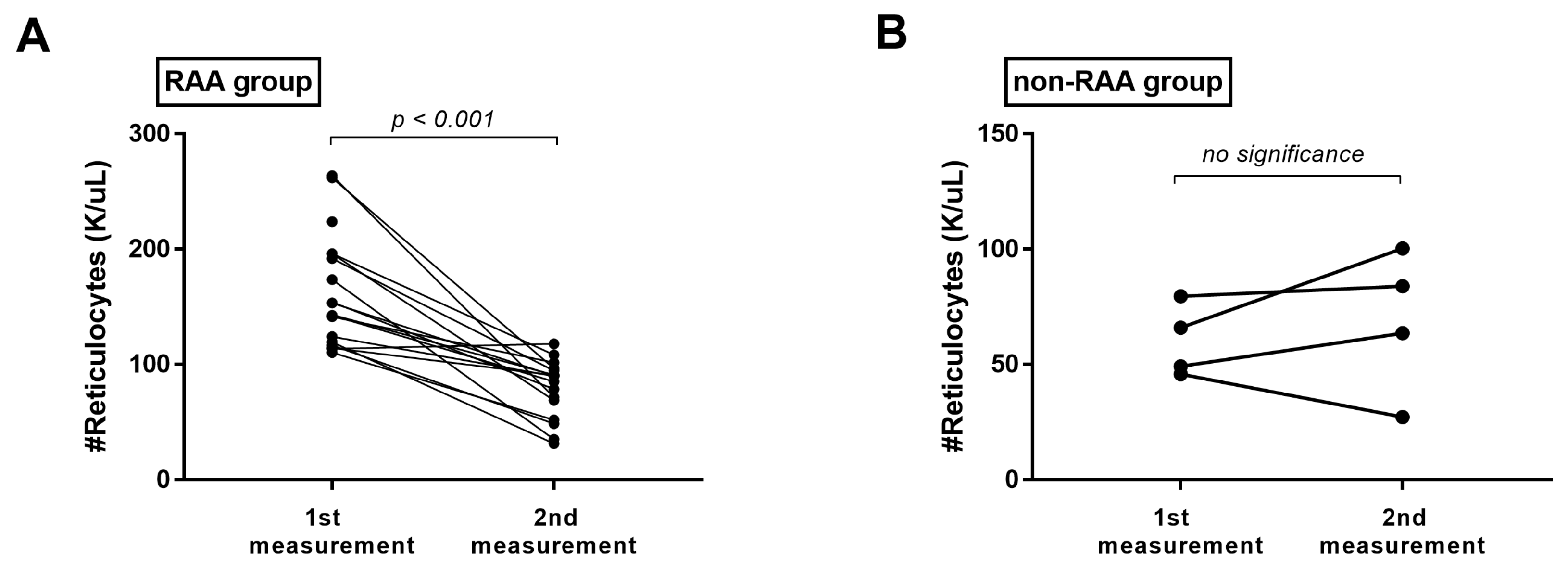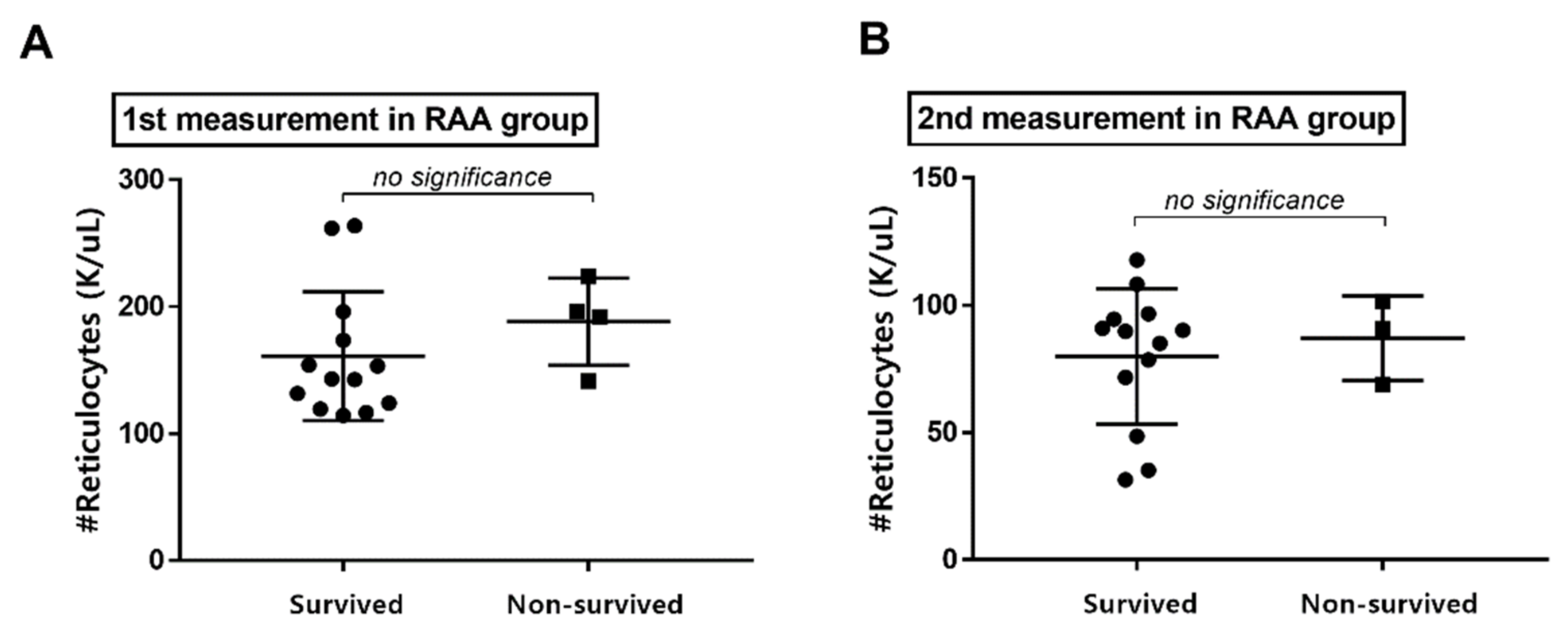Prevalence of Reticulocytosis in the Absence of Anemia in Dogs with Cardiogenic Pulmonary Edema Due to Myxomatous Mitral Valve Disease: A Retrospective Study
Abstract
1. Introduction
2. Materials and Methods
2.1. Case Selection
2.2. Diagnosis and Treatment of Cardiogenic Pulmonary Edema in Dogs
2.3. RAA Determination
2.4. Follow-Up Data
2.5. Statistical Analysis
3. Results
4. Discussion
5. Conclusions
Author Contributions
Funding
Institutional Review Board Statement
Informed Consent Statement
Data Availability Statement
Conflicts of Interest
References
- Keene, B.W.; Atkins, C.E.; Bonagura, J.D.; Fox, P.R.; Häggström, J.; Fuentes, V.L.; Oyama, M.A.; Rush, J.E.; Stepien, R.; Uechi, M. ACVIM Consensus Guidelines for the Diagnosis and Treatment of Myxomatous Mitral Valve Disease in Dogs. J. Vet. Intern. Med. 2019, 33, 1127–1140. [Google Scholar] [CrossRef] [PubMed]
- Fox, P.R. Pathology of Myxomatous Mitral Valve Disease in the Dog. J. Vet. Cardiol. 2012, 14, 103–126. [Google Scholar] [CrossRef] [PubMed]
- Li, Q.; Heaney, A.; Langenfeld-McCoy, N.; Boler, B.V.; Laflamme, D.P. Dietary Intervention Reduces Left Atrial Enlargement in Dogs with Early Preclinical Myxomatous Mitral Valve Disease: A Blinded Randomized Controlled Study in 36 Dogs. BMC Vet. Res. 2019, 15, 425. [Google Scholar] [CrossRef] [PubMed]
- Hezzell, M. Pathology and Prognosis of Canine Myxomatous Mitral Valve Disease. Practice 2018, 40, 3–6. [Google Scholar] [CrossRef]
- Adamson, J.W.; Eschbach, J.; Finch, C.A. The Kidney and Erythropoiesis. Am. J. Med. 1968, 44, 725–733. [Google Scholar] [CrossRef]
- Kendall, R.G.; Mellors, I.; Hardy, J.; Mardle, B. Patients with Pulmonary and Cardiac Disease Show an Elevated Proportion of Immature Reticulocytes. Clin. Lab. Haematol. 2001, 23, 27–31. [Google Scholar] [CrossRef] [PubMed]
- Pattullo, K.M.; Kidney, B.A.; Taylor, S.M.; Jackson, M.L. Reticulocytosis in Nonanemic Dogs: Increasing Prevalence and Potential Etiologies. Vet. Clin. Pathol. 2015, 44, 26–36. [Google Scholar] [CrossRef] [PubMed]
- Stewart, I.B.; McKenzie, D.C. The human spleen during physiological stress. Sports Med. 2002, 32, 361–369. [Google Scholar] [CrossRef] [PubMed]
- Horvath, S.J.; Couto, C.G.; Yant, K.; Kontur, K.; Bohenko, L.; Iazbik, M.C.; Marín, L.M.; Hudson, D.; Chase, J.; Frye, M.; et al. Effects of racing on reticulocyte concentrations in Greyhounds. Vet. Clin. Pathol. 2014, 43, 15–23. [Google Scholar] [CrossRef] [PubMed]
- Thomas, J.; Michael, O.; Ewell, C.W. Reticulocytosis and Hypoxemia as Prognostic Signs in Congestive Heart Failure. Circulation 1961, 24, 1151–1153. [Google Scholar] [CrossRef] [PubMed]
- Wang, C.; Zhang, H.; Cao, X.; Deng, R.; Ye, Y.; Fu, Z.; Gou, L.; Shao, F.; Li, J.; Fu, W.; et al. Red Cell Distribution Width (RDW): A Prognostic Indicator of Severe COVID-19. Ann. Transl. Med. 2020, 8, 1230. [Google Scholar] [CrossRef] [PubMed]
- Zhang, J.; DeMeo, D.L.; Silverman, E.K.; Make, B.J.; Wade, R.C.; Wells, J.M.; Cho, M.H.; Hobbs, B.D. Secondary Polycythemia in Chronic Obstructive Pulmonary Disease: Prevalence and Risk Factors. BMC Pulm. Med. 2021, 21, 235. [Google Scholar] [CrossRef] [PubMed]
- Fuchs, J.; Moritz, A.; Grußendorf, E.; Lechner, J.; Neuerer, F.; Nickel, R.; Rieker, T.; Schwedes, C.; DeNicola, D.B.; Russell, J.; et al. Reticulocytosis in Non-Anaemic Cats and Dogs. J. Small Anim. Pract. 2018, 59, 480–489. [Google Scholar] [CrossRef] [PubMed]
- Reinero, C.; Visser, L.C.; Kellihan, H.B.; Masseau, I.; Rozanski, E.; Clercx, C.; Williams, K.; Abbott, J.; Borgarelli, M.; Scansen, B.A. ACVIM Consensus Statement Guidelines for the Diagnosis, Classification, Treatment, and Monitoring of Pulmonary Hypertension in Dogs. J. Vet. Intern. Med. 2020, 34, 549–573. [Google Scholar] [CrossRef] [PubMed]
- Baron Toaldo, M.; Romito, G.; Guglielmini, C.; Diana, A.; Pelle, N.G.; Contiero, B.; Cipone, M. Prognostic Value of Echocardiographic Indices of Left Atrial Morphology and Function in Dogs with Myxomatous Mitral Valve Disease. J. Vet. Intern. Med. 2018, 32, 914–921. [Google Scholar] [CrossRef] [PubMed]
- Diana, A.; Guglielmini, C.; Pivetta, M.; Sanacore, A.; Di Tommaso, M.; Lord, P.F.; Cipone, M. Radiographic Features of Cardiogenic Pulmonary Edema in Dogs with Mitral Regurgitation: 61 Cases (1998–2007). J. Am. Vet. Med. Assoc. 2009, 235, 1058–1063. [Google Scholar] [CrossRef] [PubMed]
- Mosqueira, M.; Willmann, G.; Zeiger, U.; Khurana, T.S. Expression Profiling Reveals Novel Hypoxic Biomarkers in Peripheral Blood of Adult Mice Exposed to Chronic Hypoxia. PLoS ONE 2012, 7, e37497. [Google Scholar] [CrossRef] [PubMed][Green Version]
- Cheney, F.W.; Bishop, M.J.; Chi, E.Y.; Eisenstein, B.L. Effect of Regional Alveolar Hypoxia on Permeability Pulmonary Edema Formation in Dogs. J. Appl. Physiol. 1987, 62, 1690–1697. [Google Scholar] [CrossRef] [PubMed]
- Reissmann, K.R. Studies on the Mechanism of Erythropoietic Stimulation in Parabiotic Rats During Hypoxia. Blood 1950, 5, 372–380. [Google Scholar] [CrossRef] [PubMed]
- Rosse, W.F.; Waldmann, T.A. The Role of the Kidney in the Erythropoietic Response to Hypoxia in Parabiotic Rats. Blood 1962, 19, 75–81. [Google Scholar] [CrossRef] [PubMed]




| Characteristic | Value |
|---|---|
| Age (Mean ± SD years, range) | 12 ± 2.42, 8–16 |
| Reoccurrence (n, %) | 2, 9.54 |
| Sex | |
| Female (n, %) | 3, 14.2 |
| Spayed female (n, %) | 8, 38.0 |
| Male (n, %) | 2, 9.5 |
| Castrated male (n, %) | 8, 38.0 |
| Breed | |
| Maltese (n, %) | 17, 80.9 |
| Shih Tzu (n, %) | 3, 17.6 |
| Pomeranian (n, %) | 1, 4.7 |
Publisher’s Note: MDPI stays neutral with regard to jurisdictional claims in published maps and institutional affiliations. |
© 2022 by the authors. Licensee MDPI, Basel, Switzerland. This article is an open access article distributed under the terms and conditions of the Creative Commons Attribution (CC BY) license (https://creativecommons.org/licenses/by/4.0/).
Share and Cite
Choi, S.-J.; Yoon, W.-K.; Ahn, H.; Song, W.-J.; Choi, U.-S. Prevalence of Reticulocytosis in the Absence of Anemia in Dogs with Cardiogenic Pulmonary Edema Due to Myxomatous Mitral Valve Disease: A Retrospective Study. Vet. Sci. 2022, 9, 293. https://doi.org/10.3390/vetsci9060293
Choi S-J, Yoon W-K, Ahn H, Song W-J, Choi U-S. Prevalence of Reticulocytosis in the Absence of Anemia in Dogs with Cardiogenic Pulmonary Edema Due to Myxomatous Mitral Valve Disease: A Retrospective Study. Veterinary Sciences. 2022; 9(6):293. https://doi.org/10.3390/vetsci9060293
Chicago/Turabian StyleChoi, Sol-Ji, Won-Kyoung Yoon, Hyerin Ahn, Woo-Jin Song, and Ul-Soo Choi. 2022. "Prevalence of Reticulocytosis in the Absence of Anemia in Dogs with Cardiogenic Pulmonary Edema Due to Myxomatous Mitral Valve Disease: A Retrospective Study" Veterinary Sciences 9, no. 6: 293. https://doi.org/10.3390/vetsci9060293
APA StyleChoi, S.-J., Yoon, W.-K., Ahn, H., Song, W.-J., & Choi, U.-S. (2022). Prevalence of Reticulocytosis in the Absence of Anemia in Dogs with Cardiogenic Pulmonary Edema Due to Myxomatous Mitral Valve Disease: A Retrospective Study. Veterinary Sciences, 9(6), 293. https://doi.org/10.3390/vetsci9060293





